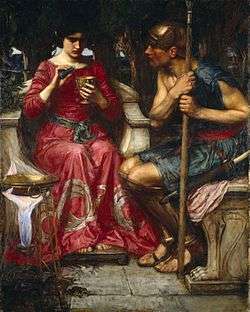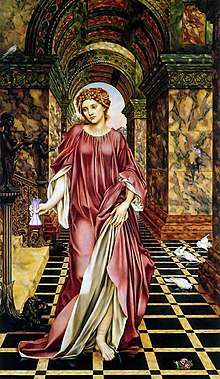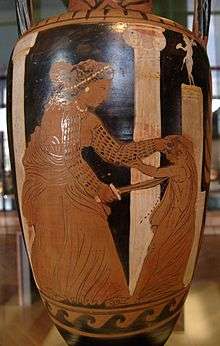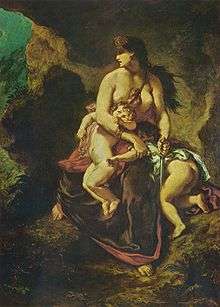Medea
In Greek mythology, Medea (/mɪˈdiːə/; Ancient Greek: Μήδεια, Mēdeia, Georgian: მედეა, Medea) is the daughter of King Aeëtes of Colchis, a niece of Circe and the granddaughter of the sun god Helios. Medea figures in the myth of Jason and the Argonauts, appearing in Hesiod's Theogony around 700 BC,[1] but best known from Euripides's tragedy Medea and Apollonius of Rhodes' epic Argonautica. Medea is known in most stories as a sorceress and is often depicted as a priestess of the goddess Hecate.

Genealogy and divinity
There have been many different accounts of Medea's family tree. One of the only uncontested facts is that she is a direct descendant of the sun god Helios (son of the Titan Hyperion) through her father King Aeëtes of Colchis. According to Hesiod (Theogony 956–962), Helios and the Oceanid Perseis produced two children Circe and Aeetes. Aeëtes then married the Oceanid Idyia and Medea was their child. This is where scholars have begun to question the rest of Medea's genealogy. By some accounts, Aeëtes and Idyia only had two daughters, Medea and Chalciope (or Chalkiope) and Apsyrtus (or Apsyrtos) was the son of Aeëtes through Asterodea. According to others, Idyia gave birth to Medea and Apsyrtus and Asterodea gave birth to Chalciope. Medea then marries Jason, although the number and names of their children are contested by different scholars. Euripides mentions two unnamed sons (whom Medea kills), others have suggested three sons (Thessalus, Alcimenes, and Tisander) two sons (Mermerus and Pheres) or a son and a daughter (Medeius and Eriopis). After Medea leaves Jason in Corinth, she marries the king of Athens (Aegeus) and bears him a son. Scholars have questioned whether her son Medeius is the son of Jason or of Aegeus, but Medeius goes on to become the ancestor of the Medes by conquering their lands.
The importance of Medea's genealogy is to help define what level of divinity she possessed. By some accounts, like the Argonautica, she is depicted as a young, mortal woman. She is directly influenced by the Greek gods (through Hera and Aphrodite) and while she possesses magical abilities, she is still a mortal with divine ancestry. Other accounts, like Euripides' play Medea, focus on her mortality, although she transcends the mortal world at the end of the play with the help of her grandfather Helios and his sun chariot. Hesiod's Theogony places her marriage to Jason on the list of marriages between mortals and divine, suggesting that she is predominantly divine. She also has connections with Hecate,[2] who was the goddess of magic, which could be one of the main sources from which she draws her magical ties.
Mythology
Jason and Medea

Medea's role began after Jason came from Iolcus to Colchis, to claim his inheritance and throne by retrieving the Golden Fleece. In the most complete surviving account, the Argonautica of Apollonius of Rhodes, Medea fell in love with him and promised to help him, but only on the condition that if he succeeded, he would take her with him and marry her. Jason agreed. In a familiar mythic motif, Aeëtes promised to give him the fleece, but only if he could perform certain tasks. First, Jason had to plough a field with fire-breathing oxen that he had to yoke himself; Medea gave him an unguent with which to anoint himself and his weapons, to protect them from the bulls' fiery breath. Next, Jason had to sow the teeth of a dragon in the ploughed field (compare the myth of Cadmus), and the teeth sprouted into an army of warriors; Jason was forewarned by Medea, however, and knew to throw a rock into the crowd. Unable to determine where the rock had come from, the soldiers attacked and killed each other. Finally, Aeëtes made Jason fight and kill the sleepless dragon that guarded the fleece; Medea put the beast to sleep with her narcotic herbs. Jason then took the fleece and sailed away with Medea, as he had promised. Apollonius says that Medea only helped Jason in the first place because Hera had convinced Aphrodite or Eros to cause Medea to fall in love with him. Medea distracted her father as they fled by killing her brother Absyrtus.
In some versions, Medea was said to have dismembered her brother's body and scattered his parts on an island, knowing her father would stop to retrieve them for proper burial; in other versions, it was Absyrtus himself who pursued them and was killed by Jason. During the fight, Atalanta, a member of the group helping Jason in his quest for the fleece, was seriously wounded, but Medea healed her. In the Argonautica, Medea and Jason stopped on her aunt Circe's island so that she could be cleansed after murdering her brother, relieving her of blame for the deed.

On the way back to Thessaly, Medea prophesied that Euphemus, the helmsman of Jason's ship, the Argo, would one day rule over all of Libya. This came true through Battus, a descendant of Euphemus.
The Argo then reached the island of Crete, guarded by the bronze man, Talos (Talus). Talos had one vein which went from his neck to his ankle, bound shut by a single bronze nail. According to Apollodorus, Talos was slain either when Medea drove him mad with drugs, deceived him that she would make him immortal by removing the nail, or was killed by Poeas's arrow (Apollodorus 1.140). In the Argonautica, Medea hypnotized him from the Argo, driving him mad so that he dislodged the nail, ichor flowed from the wound, and he bled to death (Argonautica 4.1638). After Talos died, the Argo landed.
Jason, celebrating his return with the Golden Fleece, noted that his father Aeson was too aged and infirm to participate in the celebrations. Medea withdrew the blood from Aeson's body, infused it with certain herbs, and returned it to his veins, invigorating him.[3] The daughters of king Pelias saw this and wanted the same service for their father.
While Jason searched for the Golden Fleece, Hera, who was still angry at Pelias, conspired to make Jason fall in love with Medea, who, Hera hoped, would kill Pelias. When Jason and Medea returned to Iolcus, Pelias still refused to give up his throne, so Medea conspired to have Pelias' own daughters kill him. She told them she could turn an old ram into a young ram by cutting up the old ram and boiling it in magic herbs. During her demonstration, a live, young ram jumped out of the pot. Excited, the girls cut their father into pieces and threw him into a pot. Having killed Pelias, Jason and Medea fled to Corinth.
Various sources state that Jason and Medea had between one and fourteen children, including sons Alcimenes, Thessalus, Tisander, Mermeros and Pheres, Medus, and Argos, and a daughter, Eriopis.[4] They were married for 10 years in Corinth.[5]
Various versions' endings

In Corinth, Jason abandoned Medea for the king's daughter, Glauce. Before the fifth century BC, there seem to have been two variants of the myth's conclusion. According to the poet Eumelus, to whom the fragmentary epic Korinthiaka is usually attributed, Medea killed her children by accident.[6] She buried them alive in the Temple of Hera, believing this would make them immortal.[7] The poet Creophylus, however, blamed their murders on the citizens of Corinth.[8]
According to Euripides' version, Medea took her revenge by sending Glauce a dress and golden coronet, covered in poison. This resulted in the deaths of both the princess and the king, Creon, when he went to save his daughter. Medea then continued her revenge, murdering two of her children herself. Afterward, she left Corinth and flew to Athens in a golden chariot driven by dragons sent by her grandfather, Helios, god of the sun.
Although Jason in Euripides calls Medea most hateful to gods and men, the fact that the chariot is given to her by Helios indicates that she still has the gods on her side. As Bernard Knox points out, Medea's last scene with concluding appearances parallels that of a number of indisputably divine beings in other plays by Euripides. Just like these gods, Medea “interrupts and puts a stop to the violent action of the human being on the lower level, … justifies her savage revenge on the grounds that she has been treated with disrespect and mockery, … takes measures and gives orders for the burial of the dead, prophesies the future,” and “announces the foundation of a cult.”[9]
This deliberate murder of her children by Medea appears to be Euripides' invention, although some scholars believe Neophron created this alternate tradition.[10] Her filicide would go on to become the standard for later writers.[11] Pausanias, writing in the late 2nd century AD, records five different versions of what happened to Medea's children after reporting that he has seen a monument for them while traveling in Corinth.[12]
Fleeing from Jason, Medea made her way to Thebes, where she healed Heracles (the former Argonaut) from the curse of Hera (that led to the murder of Iphitus, his best friend). In return, Heracles gave her a place to stay in Thebes until the Thebans drove her out in anger, despite Heracles' protests.
She then fled to Athens, where she met and married Aegeus. They had one son, Medus, although Hesiod makes Medus the son of Jason.[13] Her domestic bliss was once again shattered by the arrival of Aegeus' long-lost son, Theseus. Determined to preserve her own son's inheritance, Medea convinced her husband that Theseus was a threat and that he should be disposed of. As Medea handed Theseus a cup of poison, Aegeus recognized the young man's sword as his own, which he had left behind many years previously for his newborn son, to be given to him when he came of age. Knocking the cup from Medea's hand, Aegeus embraced Theseus as his own.
Medea then returned to Colchis and, finding that Aeëtes had been deposed by his brother Perses, promptly killed her uncle and restored the kingdom to her father. Herodotus reports another version, in which Medea and her son Medus fled from Athens, on her flying chariot, to the Iranian plateau and lived among the Aryans, who then changed their name to the Medes.[14]
Recounting the many variations of Medea's story, the 1st century BC historian Diodorus Siculus wrote, "Speaking generally, it is because of the desire of the tragic poets for the marvelous that so varied and inconsistent an account of Medea has been given out."[15]
Personae of Medea

In Euripides' play Medea she is a woman scorned, rejected by her husband Jason and seeking revenge. Deborah Boedeker writes about different images and symbolism used in Euripides' play to invoke responses from his original Athenian audience.[16] The Nurse gives descriptions of Medea in the prologue, highlighting comparisons to great forces of nature and different animals. There are also many nautical references throughout the play either used by other characters when describing Medea or by Medea herself. By including these references, Boedeker argues that these comparisons were used to create connections to the type of woman Medea was. She holds great power (referred to by the comparisons to forces of nature), she relies on her basic animal-like instincts and emotions (connections to different animals like bulls and lions), and it draws the audience back her original myth of Jason's quest for the Golden Fleece and the sea voyage taken by Jason, Medea, and the Argonauts.
Emma Griffiths also adds to the analysis of Medea's character in Euripides's play by discussing the male/female dichotomy created by Euripides.[2] Medea does not fit into the mold of a “normal woman” according to Athenian philosophy. She is depicted as having great intelligence and skill, something typically viewed as a masculine trait by Euripides' original audience. On the other hand, she uses that cunning in order to manipulate the men around her, and manipulation of other people would have been a negative female trait to the Athenian audience. There is also the paradox of how she chooses to murder her victims in the play. She poisons the princess, which would have been seen as a feminine way of murder, yet kills her children in cold blood, which is seen as more masculine. She also has dialogue about her children and shows a strong maternal love and connection to them, something that was essential to “normal women” in Athenian society. Yet at the end of the play she is able to kill her children as part of her revenge. It is through these opposites that Euripides creates a complicated character for his protagonist.
Although not the first depiction of Medea, the Argonautica by Apollonios Rhodios gives a fuller description of events that lead up to Euripides's play, mainly surrounding Jason's quest for the Golden Fleece. In this literary work, Medea is presented not as a powerful woman seeking justice rather she is a young woman who is desperately in love with Jason. So much in love that she decides to defy her father and kill her brother in order to help him. James J. Clauss writes about this version of Medea, attempting to unearth another version of this character for scholarship and discussion.[17] He looks into different passages in the original text to define the meaning and draw connection to the different feelings Medea was going through. He argues the feelings of Medea's initial love for Jason, the shame she feels for loving him and for going against her family, and final agreement to help Jason in his quest.
Multiple scholars have discussed Medea's use as a “helper maiden” to Jason's quest. A helper maid is typically personified as a young woman who helps on a hero's quest usually out of love. Instead of being the center of the story like she is in Euripides' Medea, this version of Medea is reduced to a supporting role. Her main purpose is to help the hero with his quest. Jason would never have been successful on his quest without Medea's help, something that is pointed out and referenced many times in ancient texts and contemporary scholarly work.
Other, non-literary traditions guided the vase-painters,[18] and a localized, chthonic presence of Medea was propitiated with unrecorded emotional overtones at Corinth, at the sanctuary devoted to her slain children,[19] or locally venerated elsewhere as a foundress of cities.[20]
Cultural depictions
Written sources
- Euripides, Medea
- Neophron, Medea (fragments from the play)
- Hyginus, Fabulae 21-26
- Pindar, Pythian Odes, IV
- Seneca: Medea (tragedy)
- Bibliotheca I, 23-28
- Apollonius Rhodius, Argonautica
- Gaius Valerius Flaccus Argonautica (epic)
- Herodotus, Histories I.2 and VII.62i
- Hesiod, Theogony 1000-2
See also
References
- Hesiod Theogony 993-1002
- Griffiths, Emma (2006). Medea. London: New York: Routledge.
- William Godwin (1876). "Lives of the Necromancers". p. 41.
- Smith, William (1870). "Medeia". A Dictionary of Greek and Roman biography and mythology: Vol 2. p. 1004. Retrieved 6 December 2016.
Her children are, according to some accounts, Mermerus, Pheres or Thessalus, Alcimenes and Tisander, and, according to others, she had seven sons and seven daughters, while others mention only two children, Medus (some call him Polyxemus) and Eriopis, or one son Argos.
- Godwin 1876, p. 42.
- As noted in a scholium to Pindar's Olympian Ode 13.74; cf. Pausanias 2.3.10-11.
- West, M. L. (2007). [www.jstor.org/stable/20191275 "A New Musical Papyrus: Carcinus, 'Medea.'"] Check
|url=value (help). Zeitschrift Für Papyrologie Und Epigraphik. 161: 1–10 – via JSTOR. - As noted in the scholium to Medea 264.
- B.M.W. Knox. Word and Action: Essays on the Ancient Theatre. Baltimore: The Johns Hopkins University Press, 1979, p. 303.
- See McDermott 1985, 10-15.
- Hyginus Fabulae 25; Ovid Met. 7.391ff.; Seneca Medea; Bibliotheca 1.9.28 favors Euripides' version of events, but also records the variant that the Corinthians killed Medea's children in retaliation for her crimes.
- Pausanias 2.3.6-11
- Hesiod Theogony 1000-2
- Herodotus Histories VII.62i
- Diodorus Siculus 4.56
- Boedeker, Deborah (1997). Medea: Essays on Medea in Myth, Literature, Philosophy, and Art. Princeton, NJ.: Princeton University Press. pp. 127–148.
- Clauss, James J. (1997). Medea: Essays on Medea in Myth, Literature, Philosophy, and Art. Princeton, NJ.: Princeton University Press. pp. 149–177.
- As on the bell krater at the Cleveland Museum of Art (91.1) discussed in detail by Christiane Sourvinou-Inwood, "Medea at a Shifting Distance: Images and Euripidean tragedy", in Clauss and Johnston 1997, pp 253-96.
- Edouard Will, Corinth 1955. "By identifying Medea, Ino and Melikertes, Bellerophon, and Hellotis as pre-Olympianprecursors of Hera, Poseidon, and Athena, he could give to Corinth a religious antiquity it did not otherwise possess", wrote Nancy Bookidis, "The Sanctuaries of Corinth", Corinth 20 (2003)
- "Pindar shows her prophesying the foundation of Cyrene; Herodotus makes her the legendary eponymous founder of the Medes; Callimachus and Apollonius describe colonies founded by Colchians originally sent out in pursuit of her" observes Nita Krevans, "Medea as foundation heroine", in Clauss and Johnston 1997 pp 71-82 (p. 71).
- Ovid also wrote a full play called Medea from which only a few lines are preserved.
Bibliography
| Wikimedia Commons has media related to Medea. |
- Apollodorus, Apollodorus, The Library, with an English Translation by Sir James George Frazer, F.B.A., F.R.S. in 2 Volumes. Cambridge, MA, Harvard University Press; London, William Heinemann Ltd. 1921.
- Clauss, J. J. and S. I. Johnston (eds), Medea: Essays on Medea in Myth, Literature, Philosophy and Art. (Princeton, Princeton University Press, 1997). ISBN 9780691043760.
- Grant, Michael, and John Hazel.Who's Who in Classical Mythology. London: Weidenfeld & Nicolson, 1973.
- Griffiths, Emma. Medea. London ; New York: Routledge, 2006.
- Knox, B.M.W.. Word and Action: Essays on the Ancient Theatre. Baltimore: The Johns Hopkins University Press, 1979.
- McDermott, Emily, Euripides' Medea: The Incarnation of Disorder. (University Park, PA, Penn State University Press, 1985). ISBN 9780271006475.
- Mossman, Judith, Medea: Introduction, Translation and Commentary. Aris & Phillips, Warminster 2011) ISBN 9780856687884
- Smith, William, Dictionary of Greek and Roman Biography and Mythology. London (1873). "Medeia or Medea"
- Wygant, Amy. Medea, Magic, and Modernity in France: Stages and Histories, 1553-1797. (Aldershot, Ashgate, 2007). ISBN 9780754659242